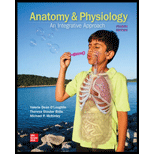
Concept explainers
_____ 1. Unencapsulated, terminal endings of dendrites of sensory neurons are called
- a. lamellated corpuscles.
- b. free nerve endings.
- c. bulbous corpuscles.
- d. end bulbs.
Introduction:
The un encapsulated tactile receptors are the tips or apex of sensory neurons which are uncovered. There are three types of unencapsulated nerve receptors: free nerve endings, root hair plexuses, and tactile discs.
Answer to Problem 1DYKB
Correct answer:
Free nerve endings are the tactile receptors which are unencapsulated on the apex.
Therefore, option (b) is correct.
Explanation of Solution
Reason for the correct statement:
Option (b) is given as “free nerve endings”. The free nerve endings are the apex of any tactile sensory receptor which is not covered by any protective layer on its end. These receptors are found very close to superficial layer of skin. The free nerve endings are sensitive to pain and temperature stimuli. These may be phasic receptor or tonic receptor.
Hence, option (b) is correct.
Reasons for incorrect statements:
Option (a), is given as “lamellated corpuscles”.
These receptors are found on the skin of fingers which is sensitive to touch and pressure. These are oval in shape and the apex of receptor is covered with a protective layer. Hence, it is incorrect
Option (c), is given as “bulbous corpuscles”.
These nerve endings are also called as ruffini endings. These receptors are found in cutaneous tissues. These are spindle shaped neurons and have a covering layer. Hence, it is incorrect.
Option (d), is given as “end bulbs”.
These are rounded or oval structures found at the nerves fiber endings. These receptors are sensitive to touch, pain and cold. These receptors are covered with a protective layer. Hence, it is incorrect.
Hence, options (a), (c), and (d) are incorrect.
Free nerve endings are the receptors which are unencapsulated. Lamellated corpuscles, bulbous corpuscles, and end bulbs are the nerve ends which contain a protective covering on their tips.
Want to see more full solutions like this?
Chapter 16 Solutions
ANATOMY+PHYSIOLOGY(LL)-W/CONNECT ACCESS
- Every tutor here has got this wrong, don't copy off them.arrow_forwardSuppose that the population from question #1 (data is in table below) is experiencing inbreeding depression (F=.25) (and no longer experiencing natural selection). Calculate the new expected genotype frequencies (f) in this population after one round of inbreeding. Please round to 3 decimal places. Genotype Adh Adh Number of Flies 595 Adh Adh 310 Adhs Adhs 95 Total 1000 fladh Adh- flAdn Adh fAdhs Adharrow_forwardWhich of the following best describes why it is difficult to develop antiviral drugs? Explain why. A. antiviral drugs are very difficult to develop andhave no side effects B. viruses are difficult to target because they usethe host cell’s enzymes and ribosomes tometabolize and replicate C. viruses are too small to be targeted by drugs D. viral infections usually clear up on their ownwith no problemsarrow_forward
- This question has 3 parts (A, B, & C), and is under the subject of Nutrition. Thank you!arrow_forwardThey got this question wrong the 2 previous times I uploaded it here, please make sure it's correvct this time.arrow_forwardThis question has multiple parts (A, B & C), and under the subject of Nutrition. Thank you!arrow_forward
- Calculate the CFU/ml of a urine sample if 138 E. coli colonies were counted on a Nutrient Agar Plate when0.5 mls were plated on the NA plate from a 10-9 dilution tube. You must highlight and express your answerin scientific notatioarrow_forwardDon't copy off the other answer if there is anyarrow_forwardAnswerarrow_forward
- HAND DRAW There should be two proarrow_forwardMolecular Biology Question. Please help solve. Thanks. Please draw how two nucleotide triphosphates are linked together to form a dinucleotide, and label the 5' and 3' ends of the resulting dinucleotide.arrow_forwardWhat is a reversion in molecular biology?arrow_forward
 Medical Terminology for Health Professions, Spira...Health & NutritionISBN:9781305634350Author:Ann Ehrlich, Carol L. Schroeder, Laura Ehrlich, Katrina A. SchroederPublisher:Cengage Learning
Medical Terminology for Health Professions, Spira...Health & NutritionISBN:9781305634350Author:Ann Ehrlich, Carol L. Schroeder, Laura Ehrlich, Katrina A. SchroederPublisher:Cengage Learning Human Physiology: From Cells to Systems (MindTap ...BiologyISBN:9781285866932Author:Lauralee SherwoodPublisher:Cengage Learning
Human Physiology: From Cells to Systems (MindTap ...BiologyISBN:9781285866932Author:Lauralee SherwoodPublisher:Cengage Learning Comprehensive Medical Assisting: Administrative a...NursingISBN:9781305964792Author:Wilburta Q. Lindh, Carol D. Tamparo, Barbara M. Dahl, Julie Morris, Cindy CorreaPublisher:Cengage Learning
Comprehensive Medical Assisting: Administrative a...NursingISBN:9781305964792Author:Wilburta Q. Lindh, Carol D. Tamparo, Barbara M. Dahl, Julie Morris, Cindy CorreaPublisher:Cengage Learning Fundamentals of Sectional Anatomy: An Imaging App...BiologyISBN:9781133960867Author:Denise L. LazoPublisher:Cengage Learning
Fundamentals of Sectional Anatomy: An Imaging App...BiologyISBN:9781133960867Author:Denise L. LazoPublisher:Cengage Learning





